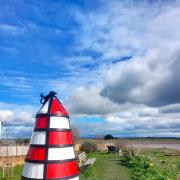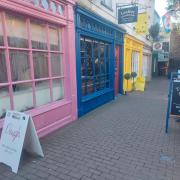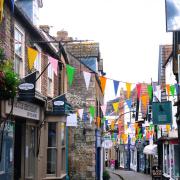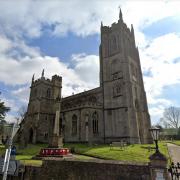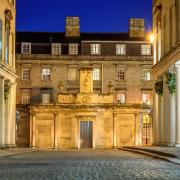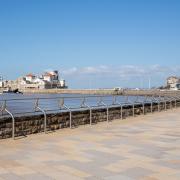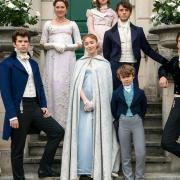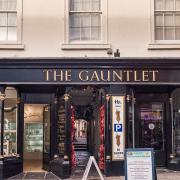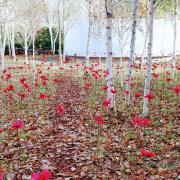Hands up everyone who watched the recent BBC series 'Cranford' and shed a little tear at the end. Part of the attraction of a good costume production is the sentimental, tissue-clenching melodrama; part is seeing Dame Judi and her like doing their...
Anyone visiting the city and wandering along the crescent is bound to be in awe of the magnificent architecture, but the chances are they're also a little bit curious about what's behind the closed doors, and more precisely what was behind closed doors when people such as Beau Nash and Ralph Allen walked the streets of Georgian Bath. No 1 provides an opportunity to satisfy that inquisitiveness.
Inside No 1 , the table is all set for a meal in the dining room - clearly tropical fruit was available for the rich in 18th-century Bath. The first-floor drawing room is the most richly decorated, as was the norm, since it was principally used for entertaining. The brightly coloured walls are hung with silk and cotton damask, and there is an excellent view of the rest of the crescent for the nosy Georgian curtain-twitcher. A prettily adorned four-poster dominates the bedroom - the pattern of the bed hangings and curtains is based on an 18th-century floral chintz discovered in North Wales.
Despite all the colourful decorations and the many objects on display, it is the practicalities of Georgian living that visitors ask about most frequently: 'How did they wash? Where is the toilet?' In fact, enter the study and you can see the cupboard hidden in the skirting board where the gentleman would keep his chamber pot.
"Because the property isn't too huge and overwhelming, it gives people a good glimpse of 18th-century life," says curator Victoria Barwell. "And because the house isn't too perfect, it has a slightly lived-in feel, which people seem to like. It really makes you feel when you walk in that somebody's just walked out the other door, and we're always trying to think of new ways to bring it to life."
What was behind closed doors when Beau Nash and Ralph Allen walked the streets of Georgian Bath?
Victoria describes the visitor reactions. "People love it, I think, mainly because it's not too formal. We don't have lots of signs and labels, and there isn't lots of information to read. Instead we have a guide in each room. Our team of more than 100 voluntary guides talk to people about how the room was used and what Bath was like at the time. So it's all done on quite an informal basis and I think visitors prefer that to having too much technology.
"All our guides are passionate about the 18th century, so they really want to enthuse people, and they're very, very knowledgeable. What they don't know about how people lived is probably not worth knowing."
The foundation stone of No 1 Royal Crescent was laid in 1767 and the house first leased to a Thomas Brock in 1769. Among subsequent notable occupants, records show that the Duke of York, second son of George III, 'engaged the first house in the Royal Crescent' in 1776.
The house has been owned and run by the Bath Preservation Trust since 1968 when it was donated by Major Bernard Cayzer, who also provided funds for many of the objects and for its restoration to Georgian glory. More artefacts have been donated or purchased over the years and several of the very fine paintings have been loaned by the Tate, the Holburne Museum in Bath and the National Portrait Gallery.
"When the house was acquired, it had fallen into quite a sad state of repair," says Victoria. "During the 19th century it had been converted into lodging rooms and some of the original features had been lost when it was divided up. It was an enormous project to restore the house. They tried as far as they could to use original materials appropriate for the 18th century, and they had to do a bit of detective work to find out where things were, such as the original doors. A lot of the fireplaces had been taken out too so they had to look at the marks on the wall to see where they had once been in order to put them back. It was a process of uncovering the hidden splendours that lay beneath." And with renowned interior decorator Jean Munro and experts from the Victoria and Albert Museum on board, many of the leading authorities of the time were involved in the restoration.
Victoria is keen to strengthen the museum's education provision through lecture series and 'living history' events. Last year there was a series entitled 'Behind the Fan', which was all about how Georgian women were able to influence their world, by using fashion, for instance, as a political statement.
The rooms of No 1 all look very smart, tidy and elegant, but there is another side. "In the dining room we very often explain that it could be quite basic really. The gentlemen could get quite raucous and would usually stay behind and drink until they fell under the table. They thought nothing of having a pot in the corner and getting up and spending a penny before sitting down again, so it's not all as elegant as you might think and the guides are very good at bringing all this to life." In words, that is, not living history. BY MALCOLM RIGBY
No 1 Royal Crescent, Bath, BA1 2LR, tel 01225 428126, www.bath-preservation-trust.org.uk.





